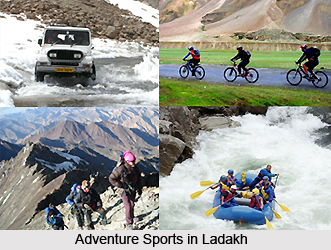 Amidst picturesque landscapes and rugged beauty, Ladakh has many options for undertaking adventure activities. Besides being an ideal location for nature lovers, Ladakh is also a favourite among the adventure enthusiasts. Being pre-dominantly a mountainous region, the region offers an incomparable range of options for adventure sports like mountaineering, trekking, camel safari, river rafting, etc. Other than these, there are also traditional sports like polo, jeep safari, cycling and archery which are equally fun and exciting.
Amidst picturesque landscapes and rugged beauty, Ladakh has many options for undertaking adventure activities. Besides being an ideal location for nature lovers, Ladakh is also a favourite among the adventure enthusiasts. Being pre-dominantly a mountainous region, the region offers an incomparable range of options for adventure sports like mountaineering, trekking, camel safari, river rafting, etc. Other than these, there are also traditional sports like polo, jeep safari, cycling and archery which are equally fun and exciting.
Trekking in Ladakh
Known to be one of the most popular adventure sports in the region, Trekking is not only about scaling high passes, mountains or any other geographical adversity. It is actually about experiencing and exploring the culture and heritage of the region. The hilly terrain of Ladakh offers a wide range of option from short all day long walks scaling up and down the mountain slopes to visit monuments or monasteries, or long trans-mountain treks involving weeks of walking and camping in the wilderness.
The season for Trekking in Ladakh normally extends from the months of early June to mid-October. But short, localised treks within the central Indus valley can be undertaken even in the month of May. On the other hand, some routes are suitable only for the late autumn as during the summer the tracks are submerged due to excessive flow of water, like the trek of Hemis-Markha-Padum. The winter access to the Zanskar Range is actually along the frozen surface of the Zanskar River, and is called the Chaddar route. This Trekking route in Ladakh, though difficult and highly demanding in terms of arrangements, is perhaps one of the most exciting and memorable treks in the country.
Mountaineering in Ladakh
Another popular adventure sport of Ladakh, Mountaineering is possible here because of the presence of a hilly terrain and an ample scope of several peaks. The most frequented area by travellers is the Nun-Kun massif in the Great Himalayan Range because of its easy accessibility from the Kargil-Padum road and the shortest possible approach march to the base camps makes this massif the most attractive climbing destination in the Great Himalayas. Some of the peaks which can be reached from the Leh-Kargil road are the Stok Kangri Peak standing at an elevation of 6121 m in the Zanskar and the Kangyaze Peak at 6400 m to the south east of Leh. Mountain ranges like the Karakoram, Zanskar and Ladakh Ranges are famous for allowing mountaineering. Other peaks, such as the Golaib Khangri and the Kangyatse peak also offer mountaineering opportunities.
The ideal period for mountaineering is between the months of June to September because it is the only time when the Ladakh region remains unaffected by the monsoon. The concept of mountain biking is also an option here, the rock strewn setting and a wide range of trails with the imposing snow covered mountains and striking panoramas, fascinate the traveller.
River Rafting in Ladakh
River Rafting in Ladakh takes one through the picturesque landscape while traversing through the deep waters amidst cavernous canyons and soaring snow-covered peaks. Ladakh offers a range of rafting options on the Indus and its major tributaries. The best stretch for professionally guided runs in white water is on the Indus between Spituk and Nimu or Saspol. Upstream of Spituk, the Indus has the easiest stretch up to Karu, which is ideal for beginners to learn the basics. The most difficult and exciting rafting option is available on the Zanskar River, along its spectacular course through a gorge in the Zanskar Mountains, between Padum and Nimu.
Camel Safari in Ladakh
Riding on a double humped camel and scaling the beautiful landscapes of the high altitude desert is quickly becoming a popular adventure sport in the region. Extensively used by the Central Asian traders to explore the rugged terrains of Ladakh since the ancient times and is now the hot favourite among tourists. Quite popular in the Diskit and Hunder valley, safari on these camels will take one through the enchanting sand dunes and the nooks and corners of the valley, which are otherwise difficult to be reached on a vehicle.
Other than these, archery and polo is also quite popular in the region. There is a National Archery Stadium in Leh that hosts Archery Contests in Ladakh.



















